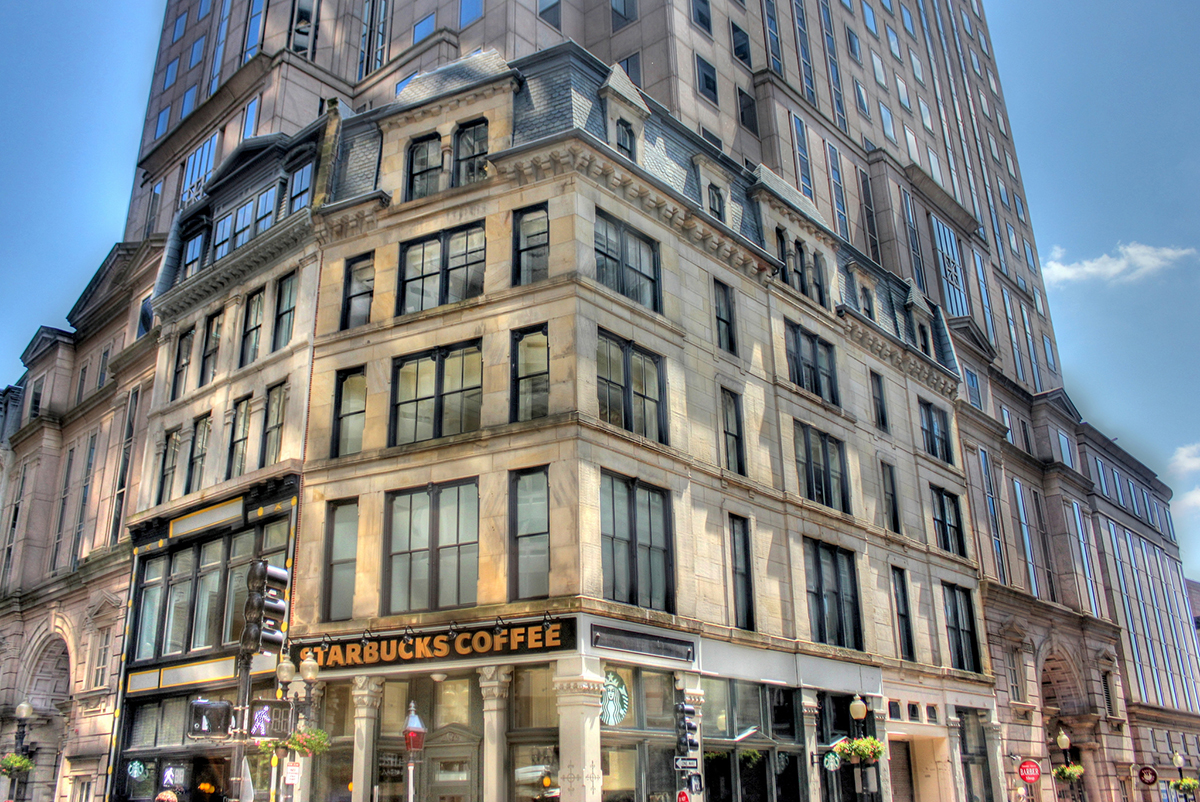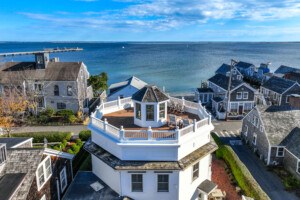Zillow’s ‘Starbucks Effect’ Has Venti-Sized Holes

Starbucks on Summer Street, Downtown. / Photo via Oleg Shpyrko on Flickr
No coffee-guzzling American can deny that Starbucks is iconic. Sure, we make fun of how its trendy cups o’ pumpkin-spiced joe are just so à la mode, but there is no sense in disagreeing that parading the green siren emblem makes you, as a consumer, cool.
However, Starbucks’ cool-factor is not just limited to consumers; the coffeehouse, as it turns out, is supposed to be a complete goldmine for homeowners. In an excerpt from Zillow Talk, a book written by the real estate database company’s CEO Spencer Rascoff and Chief Economist Stan Humphries, a concept dubbed the “Starbucks Effect” shows evidence that living within a close vicinity of the coffee shop directly correlates with rising home values, and that Starbucks is “the fuel, not the follower” for neighborhood gentrification.
Rascoff and Humphries claim that Starbucks “equals big bucks.” While on average, American homes appreciated 65 percent between 1997 and 2014, homes within a quarter mile of a Starbucks appreciated 96 percent. Zillow also examined metro areas where Starbucks boosted home values the most, and the city of Boston topped the chart, outpacing markets in Baltimore, D.C., and Chicago.
Interested in finding more specific data, we reached out to Zillow, and they ran their algorithm for properties with Boston addresses. Here’s the conclusion they delivered:
In Boston, the median value of all homes in 1997 was $155,600, and that increased by December 2013 to $351,100, an increase of 125.6 percent.
Boston homes within a quarter mile of a Starbucks in January 1997 were valued at a median of $175,930. In December 2013, their median value was $476,778—a 171 percent increase.
With just a quick browse through the Globe’s archives, we know that Starbucks really made its mark on this city back in 1994 when they bought out Coffee Connection. Those 18 locations adopted the Starbucks name in 1995. Now, 20 years later, Starbucks has roughly 60 locations, mapped out below. *
But it’s worth noting that while Starbucks has made its mark in Boston and Zillow’s numbers are undoubtedly valid, home values appreciate for a number of reasons, especially over the span of 17 years. Without knowing specifics about other neighborhood changes, home renovations, tax increases, etc., it’s hard to confirm or debunk the fact that Starbucks causes home values to rise.
We can, however, address the second piece of their claim: that the coffee chain is “the fuel, not the follower”—a proxy for gentrification, not the ones seeking it. We turned to Stan Humphries, co-author of Zillow Talk, and asked for clarification on what it means to be “the fuel” versus “the follower.”
“Starbucks is both the cause and effect,” he told us. “Starbucks is both following home price trends and neighborhoods, and in turn is fueling those trends.”
Because it’s not always possible to be both the chicken and the egg, we observed recently flourishing areas of the city to see if Starbucks played a role as the fuel, the follower, or both, based on development timelines.
First, we spoke to real estate agent David Bates, a property trends writer and creator of the Bates Real Estate Report. He wrote to us via email with the following:
It’s hard to poke holes in their conclusions without seeing more of their data and method, but my thought is that seeing a Starbucks might be a sign that there will be good appreciation in the neighborhood. That’s because I think Starbucks needs locations of high traffic, either densely populated city locations or very busy streets. Starbucks is a high-end coffee retailer, and unlike Dunkin’ Donuts, they’re most profitable on clientele that won’t blink an eye at spending $5 for a drink.
If I was an investor [and] invested in the best market and avoided the worst markets, I think I would have a much better return than the market average, and of course, a significantly better return than the markets where I was absent. But another aspect to their location strategy is keeping a close eye for signs that an area has changed, has become more upscale, with more discretionary income.
It makes good business sense to be selective about locations, and companies like Starbucks spend a lot of time and energy into deciding where to lay down their roots, which is something Humphries discussed with us as well.
But more to Bates’s point, the Green District is a privately funded, eco-friendly community in Allston that started development in 2012. The goal was high-quality, middle-market housing for young people, with six buildings bound on the block between Commonwealth Avenue, Redford Street, Brainerd Road, and Griggs Street. The Green District has a Starbucks located in its retail strip at 1304 Commonwealth Avenue. But according to reports from 2014, that Starbucks didn’t open until May 1 of last year—nearly two years after the Green District project was already underway.
Bruce Percelay of the Mount Vernon Company, who owns the property, said in 2014 that Starbucks looked at this site three years ago, but with some parts of the project unclear, they took a “wait-and-see approach.”
The case is similar at a condo complex at 11 West Broadway in South Boston. The Starbucks that sits at the base of the property sought permission for the space in 2012 when the residential development was nearly finished. That Starbucks opened in August 2013.
“Is Starbucks provoking an increase in value in South Boston?” David Bates asked. “I don’t think so. To an extent, the Starbucks location is not even considered South Boston by real estate brokers who advertise very high-end properties located in it. In my opinion, Starbucks might be a sign that an area has received a huge capital development, but it’s not the reason for appreciation—the development is.”
While that presumption makes sense, it’s the timeline that ultimately plays a key role when determining what’s the “fuel” and what’s the “follower.” For more clarity on Starbucks’ agenda, we turned to Esri, the company that helps the chain—among many other retailers—fine-tune how to pick a store location using their map-driven geographic analysis. Simon Thompson, Esri’s Director of Commercial Relations, says it’s a “sweet-spot analysis” and “a circle of demographics, financial investment, and timing,” where all the parties involved have the same insight and awareness.
On the retailer’s end, they’re very aware of development timelines, Thompson told us. “They tend to work with local brokers and people who are aware of the market. Generally, they want to be the first to execute. If you’re negotiating a lease while condos are being built, you’re too late. You want to be ready when they open. Timing is everything.”
Yes, timing is everything. Laura Ahmes Gollinger, Vice President of the Collaborative Companies, whose role is to provide input to developers on where to build, brought our attention to Ink Block. The new development on Harrison Avenue in the South End has a rental building, a condo building, a hotel component, and a new-concept Whole Foods including a spa and juice bar. The area has been undergoing changes for the past year and a half, she pointed out, but no word of a Starbucks.
“Starbucks is becoming more generational,” she said. “The trend right now is looking into micro-cafes. People are looking to keep things local.” Ink Block, for example, has Flat Black Coffee Co. and a cafe inside Mohr & McPherson.
Ultimately, Gollinger said, city folks crave residential infrastructure and a walkability factor: “A grocery store, pharmacy, and cool restaurants are conveniences people are looking for.”
While it looks like Starbucks may be more of the follower than the fuel, this doesn’t mean that its presence in the neighborhood is insignificant. Gollinger affirmed that the coffee chain “is an indicator of a market’s arrival,” which Humphries alluded to as a neighborhoods “stamp of approval.” It’s the signal that this area is up-and-coming, and people better hop on the cool caboose before it takes off.
From the buyer’s standpoint, a home’s desirability might come in part from a Starbucks, but more likely what the many things Starbucks represents. It’s no secret that coffee allegiances run deep around here, but ultimately, this phenomenon could just as easily be called the “Higher-End Anything Effect.”
* Editor’s Note: Neighborhood outlines are rough estimates based on Google Maps.


